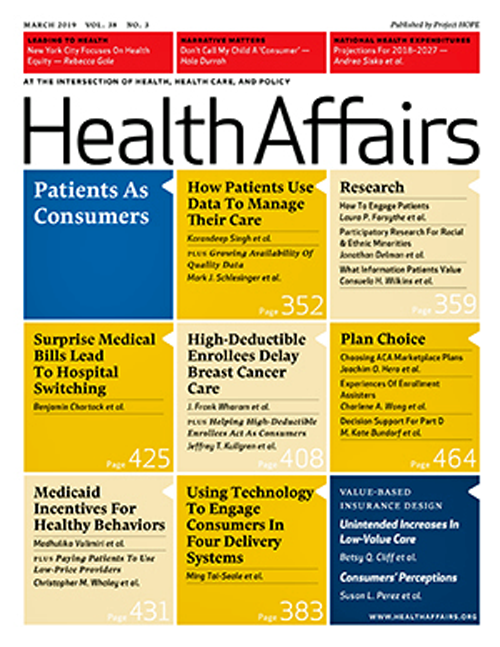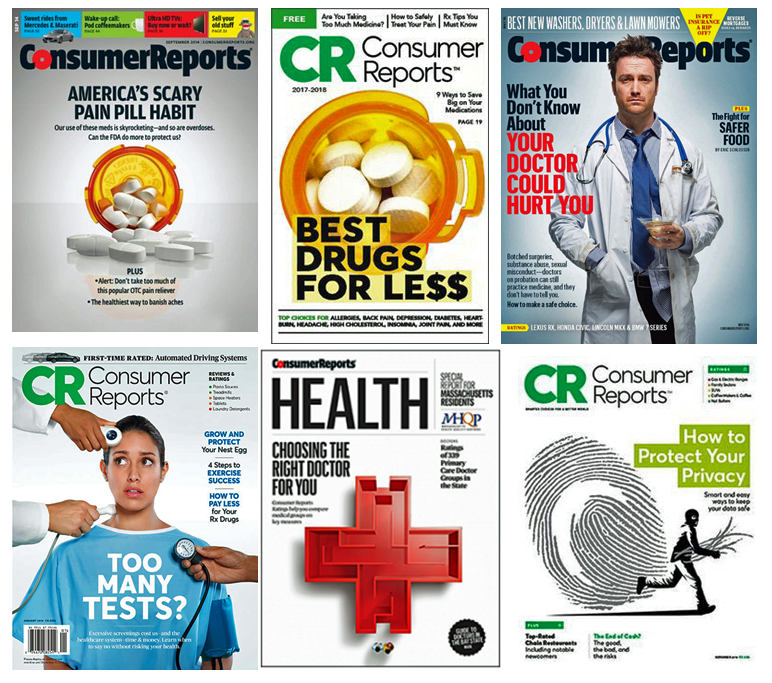 “Patients as Consumers” is the theme of the Health Affairs issue for March 2019. Research published in this trustworthy health policy publication covers a wide range of perspectives, including the promise of patients’ engagement with data to drive health outcomes, citizen science and participatory research where patients crowdsource cures, the results of financial incentives in value-based plans to drive health care “shopping” and decision making, and ultimately, whether the concept of patients-as-consumers is useful or even appropriate.
“Patients as Consumers” is the theme of the Health Affairs issue for March 2019. Research published in this trustworthy health policy publication covers a wide range of perspectives, including the promise of patients’ engagement with data to drive health outcomes, citizen science and participatory research where patients crowdsource cures, the results of financial incentives in value-based plans to drive health care “shopping” and decision making, and ultimately, whether the concept of patients-as-consumers is useful or even appropriate.
Health care consumerism is a central focus in my work, and so it’s no surprise that I’ve consumed every bit of this publication. [In full disclosure, last year when this issue was being curated, I was part of a team that proposed to submit an article for the publication, but our submission was not accepted].
I will weave findings from four of the papers in this post, for purposes of getting to the question I ask in the title above: what is the right noun to use for U.S. patients in 2019 — patients, consumers, people, health citizens?
The paper that asserts “no” to the question comes from Michael Gusmano, Karen Maschke, and Mildred Solomon, all associated with the Hastings Center which does research into bioethics. The authors note that “consumer-driven” health care is, “associated with neoliberal efforts to emphasize market factors in health reform,” de-emphasizing government regulation and financing. This concept can be potentially harmful, they believe, assuming that health care is a traditional market. “A consumer metaphor places disproportionate burdens on patients to reduce health care costs,” they posit, placing the burden of cost containment on patients. While price transparency is a sound concept, it’s not a panacea, the authors contend. “Patient-centered” approaches are constructive because they bring patients’ values into clinical care. Asking consumers to shop for services and be “prudent purchasers” of services? That’s too great a burden to put on patients, which could pressure clinicians to make unsound treatment decisions.
Now consider what happens when consumers (the noun chosen by the authors of the second paper I’m adding to the mix) access data, information and tools for self-management in health care. Karandeep Singh of the University of Michigan (GO BLUE! my alma mater) and colleagues track the growth of consumer-facing digital health tools and initiatives leading to consumers’ engagement with websites and apps. The article plots a brief history of the HITECH Act which fostered EHR adoption among clinicians and hospitals, the Blue Button program at the Veterans Health Administration enabling patients’ access to health data, OpenNotes, patient-generated data through wearable tech and smartphone apps, and consumer-grade medical devices like the AliveCor ECG and KardiaBand accessory for the Apple Watch. Singh et. al. point to limitations of consumers’ universal embrace and sustained use of these digital health tools, including low adoption of patient portals (especially among younger people, members of minority groups, healthy people, and those with less education), patient-generated data lack of interoperability with electronic health records, search engine over-dependence (that is, when “paging Dr. Google” yields sub-optimal results for the patient to act on), and lack of transparent and useful, high-quality data online. The authors call for improved regulation from the Federal Trade Commission (FTC), the U.S. agency responsible for monitoring claims and the use of personal data out-of-health-context.
Article #3 in my deep dive here extends the second analysis into digital health information, next focusing on Americans’ use of quality information on doctors. Mark Schlesinger of Yale partnered with seven other researchers from RAND and other organizations to explain the history of clinician quality information (“report cards,” patient experience surveys and clinical quality metrics, among the different types of information available to consumers) and results of surveys assessing the impact of this information on a consumer’s choice of physician. The research found that peoples’ exposure to clinician quality information doubled between 2010 and 2015, and more consumers sought quality metrics — albeit, with differences across sub-groups of people (e.g., racial and ethnic minority consumers were better informed that whites over time, and people with more education also saw more of the quality information). The good news: that Americans have become more aware of information comparing clinician quality, and more often seek that information than they have in the past — especially other patients’ comments about doctors. The authors warn, though, that consumers may tend to over-trust and -use that patient-reported information more than some of the objective clinician quality and safety metrics. Furthermore, the difference in information seeking between more educated Americans versus less could exacerbate health disparities and the inequities of health literacy.
Finally, to the fourth paper, looking at the roles of assisters and automated decision support tools in consumers’ health insurance marketplace choices. This study assessed consumers’ search for health insurance marketplace plans extended through the Affordable Care Act, analyzing the experience of 32 “assisters,” trained professionals who help consumers navigate their choice of plans. These people included the official “navigators” conceived and funded by the ACA, certified application counselors, and other people who help consumers identify health insurance plans on the marketplaces. For context, the authors note that over 5,000 marketplace assister programs provided outreach and enrollment to consumers in the third open enrollment period 2015-16. Additional context here is that President Trump cut funding for navigators in federally facilitated marketplaces by over 80%, documented here in a report from the Kaiser Family Foundation. The bottom line of this fourth paper is that consumers need support to understand their health plan choices, but resourcing that support is costly and politically controversial in the current political environment.
Taken together, these four papers from Health Affairs lead to the following themes:
- By 2019, patients in the U.S. have been compelled, by both the structure of the ACA marketplaces and the evolving consumer-directed health plan designs adopted by commercial plans and employers. to take on aspects of consumer behavior relative to personal health care choices — related to both health insurance and financing, along with clinician decisions.
- Not all patients are willing to or in the moment able to exercise these consumer muscles, whether due to health literacy and education differences, access to digital health tools (including broadband connectivity), or simply lower willingness to engage.
- Even when willing and fully armed with digital health tools and information access, being a “health care consumer” can lead people to make sub-optimal decisions for themselves, and potentially find their clinicians in compromised roles when making therapeutic treatment choices.
As Alan Weil summarized in the March 2019 Health Affairs Editor-in-Chief introduction, there are “ups and downs of expecting patients to act as consumers.”

Health Populi’s Hot Points: We can find discussions about health care consumerism in every major health care journal, and the popular press, as well. Just two weeks ago, I read the cover story, “It’s still the prices, stupid,” shown here from the cover of Modern Healthcare dated 25 February 2019.
In the article to which this assertion ties, Harris Meyer talks about the growing push for price regulation in the U.S. — most visibly for prescription drugs, and increasingly for other line items in the medical bill like nursing home care, hospital care, and physician services.
Sixteen pages after the start of the price regulation article in Modern Healthcare, you’ll find another story on hospitals looking for ways to address social needs: housing, transportation, and healthy food access among them. I’ve argued that, instead of allocating over 18% of U.S. GDP to medical care spending, America should reallocate some of these dollars to SDoH. Just today, the New York Times featured an in-depth article on the poor air quality in Pittsburgh, one of the key influences on human health that can be at least as bad for a population as smoking a pack of cigarettes a day — with subsequent negative health and financial impacts on the individual and community.
While our health care trade press re-iterates Uwe Reinhardt’s and Gerard Anderson’s observation that, “It’s the prices, stupid” from back in 2003, closer to peoples’ homes and real lives, Consumer Reports and TIME magazine also try and support Americans’ health consumer muscle/brain) development and ethos.

Here in my curated selection of CR covers, you’ll find research into prescription drug prices, pain pills, over-treatment, picking the right doctor, and protecting one’s privacy.
Many of us who chat via Twitter and LinkedIn, and in health care conferences throughout the year, have wrestled with what we should “call” patients — whether consumers, people, citizens. This is not a new-new question, I assure you. Been there. Asked that.
As my thinking continues to evolve, I will share some of the most recent segment my learning journey. I became a citizen of Italy, and thus the European Union (EU), last year, retaining my U.S. citizenship. When I proudly and humbly took my oath at the Italian Consulate in Philadelphia, I immediately became a health citizen of the EU, along with being covered by the privacy protections of the GDPR. This was one of those lifetime lightbulb moments for me both personally and professionally.
It led me to reinforce my belief in the concept of health citizenship for my fellow and sister Americans. I’ll be sharing more about that with you in my upcoming book on health care consumerism and beyond….so stay tuned for that plotline. For now, please read the entire March 2019 issue of Health Affairs to challenge and inform your own appreciation for and understanding of the patient-vs-consumer debate. Words do matter.
The post Patients, Health Consumers, People, Citizens: Who Are We In America? appeared first on HealthPopuli.com.
Patients, Health Consumers, People, Citizens: Who Are We In America? posted first on http://dentistfortworth.blogspot.com
No comments:
Post a Comment